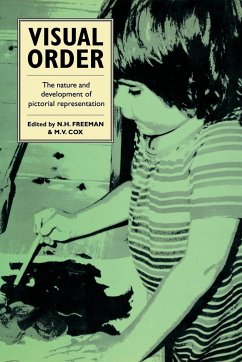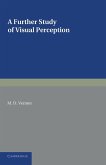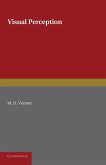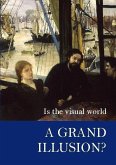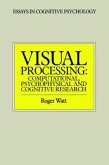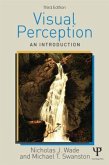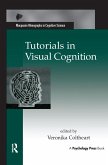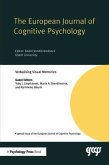Visual Order
The Nature and Development of Pictorial Representation
Herausgeber: Freeman, N. H.; N. H., Freeman; Cox, M. V.
Visual Order
The Nature and Development of Pictorial Representation
Herausgeber: Freeman, N. H.; N. H., Freeman; Cox, M. V.
- Broschiertes Buch
- Merkliste
- Auf die Merkliste
- Bewerten Bewerten
- Teilen
- Produkt teilen
- Produkterinnerung
- Produkterinnerung
This collection of essays researches the nature and development of pictorial representation.
Andere Kunden interessierten sich auch für
![A Further Study of Visual Perception A Further Study of Visual Perception]() M. D. VernonA Further Study of Visual Perception42,99 €
M. D. VernonA Further Study of Visual Perception42,99 €![Visual Perception Visual Perception]() M. D. VernonVisual Perception46,99 €
M. D. VernonVisual Perception46,99 €![Is the Visual World a Grand Illusion? Is the Visual World a Grand Illusion?]() Is the Visual World a Grand Illusion?34,99 €
Is the Visual World a Grand Illusion?34,99 €![Visual Processing Visual Processing]() R. J. WattVisual Processing71,99 €
R. J. WattVisual Processing71,99 €![Visual Perception Visual Perception]() Nicholas WadeVisual Perception83,99 €
Nicholas WadeVisual Perception83,99 €![Tutorials in Visual Cognition Tutorials in Visual Cognition]() Tutorials in Visual Cognition106,99 €
Tutorials in Visual Cognition106,99 €![Verbalising Visual Memories Verbalising Visual Memories]() Verbalising Visual Memories46,99 €
Verbalising Visual Memories46,99 €-
-
-
This collection of essays researches the nature and development of pictorial representation.
Hinweis: Dieser Artikel kann nur an eine deutsche Lieferadresse ausgeliefert werden.
Hinweis: Dieser Artikel kann nur an eine deutsche Lieferadresse ausgeliefert werden.
Produktdetails
- Produktdetails
- Verlag: Cambridge University Press
- Seitenzahl: 412
- Erscheinungstermin: 31. Oktober 2009
- Englisch
- Abmessung: 229mm x 152mm x 24mm
- Gewicht: 666g
- ISBN-13: 9780521127097
- ISBN-10: 0521127092
- Artikelnr.: 28111044
- Herstellerkennzeichnung
- Libri GmbH
- Europaallee 1
- 36244 Bad Hersfeld
- gpsr@libri.de
- Verlag: Cambridge University Press
- Seitenzahl: 412
- Erscheinungstermin: 31. Oktober 2009
- Englisch
- Abmessung: 229mm x 152mm x 24mm
- Gewicht: 666g
- ISBN-13: 9780521127097
- ISBN-10: 0521127092
- Artikelnr.: 28111044
- Herstellerkennzeichnung
- Libri GmbH
- Europaallee 1
- 36244 Bad Hersfeld
- gpsr@libri.de
List of contributors
Preface
Introduction N. H. Freeman and M. V. Cox
1. How meaning covers the traces Alan Costall
Commentary N. H. Freeman and M. V. Cox
2. A perspective on traditional artistic practices Francis Pratt
3. There is no development in art Margaret A. Hagen
4. Drawing systems revisited: the role of denotation systems in children's figure drawings John Willats
5. The adolescent's point of view: studies of forms in conflict R. K. Duthie
Commentary N. H. Freeman and M. V. Cox
6. On the discovery, storage and use of graphic descriptions W. A. Phillips, M. Inall and E. Lauder
7. Anomalous drawing development: some clinical studies Lorna Selfe
Commentary N. H. Freeman and M. V. Cox
8. Young children's representational drawings of solid objects: a comparison of drawing and copying May Jane Chen
9. Some children do sometimes do what they have been told to do: task demands and verbal instructions in children's drawing M. D. Barrett, A. V. Beaumont and M. S. Jennett
10. One object behind another: young children's use of array-specific or view-specific representations M. V. Cox
11. The canonical bias: young children's drawings of familiar objects Alyson M. Davies
12. The development of view-specific representation considered from a socio-cognitive standpoint Paul Light
13. Three into two won't go: symbolic and spatial coding processes in young children's drawings Nigel Ingram
14. Knowledge and appearance Charles Crook
15. The head is smaller than the body: but how does it join on? Juri Allik and Tiia Laak
Commentary N. H. Freeman and M. V. Cox
16. Geometrical foundations of children's drawing Michael C. Mitchelmore
17. Figural biases and young children's drawings J. Gavin Bremner
18. Cross-cultural analysis of drawing errors Ruvide Bayraktar
19. The perceptual-motor skill of drawing Judith I. Laszlo and Pia A. Broderick
20. The transition from construction to sketching in children's drawings Larry Fenson
Conclusions N. H. Freeman and M. V. Cox
Indexes.
Preface
Introduction N. H. Freeman and M. V. Cox
1. How meaning covers the traces Alan Costall
Commentary N. H. Freeman and M. V. Cox
2. A perspective on traditional artistic practices Francis Pratt
3. There is no development in art Margaret A. Hagen
4. Drawing systems revisited: the role of denotation systems in children's figure drawings John Willats
5. The adolescent's point of view: studies of forms in conflict R. K. Duthie
Commentary N. H. Freeman and M. V. Cox
6. On the discovery, storage and use of graphic descriptions W. A. Phillips, M. Inall and E. Lauder
7. Anomalous drawing development: some clinical studies Lorna Selfe
Commentary N. H. Freeman and M. V. Cox
8. Young children's representational drawings of solid objects: a comparison of drawing and copying May Jane Chen
9. Some children do sometimes do what they have been told to do: task demands and verbal instructions in children's drawing M. D. Barrett, A. V. Beaumont and M. S. Jennett
10. One object behind another: young children's use of array-specific or view-specific representations M. V. Cox
11. The canonical bias: young children's drawings of familiar objects Alyson M. Davies
12. The development of view-specific representation considered from a socio-cognitive standpoint Paul Light
13. Three into two won't go: symbolic and spatial coding processes in young children's drawings Nigel Ingram
14. Knowledge and appearance Charles Crook
15. The head is smaller than the body: but how does it join on? Juri Allik and Tiia Laak
Commentary N. H. Freeman and M. V. Cox
16. Geometrical foundations of children's drawing Michael C. Mitchelmore
17. Figural biases and young children's drawings J. Gavin Bremner
18. Cross-cultural analysis of drawing errors Ruvide Bayraktar
19. The perceptual-motor skill of drawing Judith I. Laszlo and Pia A. Broderick
20. The transition from construction to sketching in children's drawings Larry Fenson
Conclusions N. H. Freeman and M. V. Cox
Indexes.
List of contributors
Preface
Introduction N. H. Freeman and M. V. Cox
1. How meaning covers the traces Alan Costall
Commentary N. H. Freeman and M. V. Cox
2. A perspective on traditional artistic practices Francis Pratt
3. There is no development in art Margaret A. Hagen
4. Drawing systems revisited: the role of denotation systems in children's figure drawings John Willats
5. The adolescent's point of view: studies of forms in conflict R. K. Duthie
Commentary N. H. Freeman and M. V. Cox
6. On the discovery, storage and use of graphic descriptions W. A. Phillips, M. Inall and E. Lauder
7. Anomalous drawing development: some clinical studies Lorna Selfe
Commentary N. H. Freeman and M. V. Cox
8. Young children's representational drawings of solid objects: a comparison of drawing and copying May Jane Chen
9. Some children do sometimes do what they have been told to do: task demands and verbal instructions in children's drawing M. D. Barrett, A. V. Beaumont and M. S. Jennett
10. One object behind another: young children's use of array-specific or view-specific representations M. V. Cox
11. The canonical bias: young children's drawings of familiar objects Alyson M. Davies
12. The development of view-specific representation considered from a socio-cognitive standpoint Paul Light
13. Three into two won't go: symbolic and spatial coding processes in young children's drawings Nigel Ingram
14. Knowledge and appearance Charles Crook
15. The head is smaller than the body: but how does it join on? Juri Allik and Tiia Laak
Commentary N. H. Freeman and M. V. Cox
16. Geometrical foundations of children's drawing Michael C. Mitchelmore
17. Figural biases and young children's drawings J. Gavin Bremner
18. Cross-cultural analysis of drawing errors Ruvide Bayraktar
19. The perceptual-motor skill of drawing Judith I. Laszlo and Pia A. Broderick
20. The transition from construction to sketching in children's drawings Larry Fenson
Conclusions N. H. Freeman and M. V. Cox
Indexes.
Preface
Introduction N. H. Freeman and M. V. Cox
1. How meaning covers the traces Alan Costall
Commentary N. H. Freeman and M. V. Cox
2. A perspective on traditional artistic practices Francis Pratt
3. There is no development in art Margaret A. Hagen
4. Drawing systems revisited: the role of denotation systems in children's figure drawings John Willats
5. The adolescent's point of view: studies of forms in conflict R. K. Duthie
Commentary N. H. Freeman and M. V. Cox
6. On the discovery, storage and use of graphic descriptions W. A. Phillips, M. Inall and E. Lauder
7. Anomalous drawing development: some clinical studies Lorna Selfe
Commentary N. H. Freeman and M. V. Cox
8. Young children's representational drawings of solid objects: a comparison of drawing and copying May Jane Chen
9. Some children do sometimes do what they have been told to do: task demands and verbal instructions in children's drawing M. D. Barrett, A. V. Beaumont and M. S. Jennett
10. One object behind another: young children's use of array-specific or view-specific representations M. V. Cox
11. The canonical bias: young children's drawings of familiar objects Alyson M. Davies
12. The development of view-specific representation considered from a socio-cognitive standpoint Paul Light
13. Three into two won't go: symbolic and spatial coding processes in young children's drawings Nigel Ingram
14. Knowledge and appearance Charles Crook
15. The head is smaller than the body: but how does it join on? Juri Allik and Tiia Laak
Commentary N. H. Freeman and M. V. Cox
16. Geometrical foundations of children's drawing Michael C. Mitchelmore
17. Figural biases and young children's drawings J. Gavin Bremner
18. Cross-cultural analysis of drawing errors Ruvide Bayraktar
19. The perceptual-motor skill of drawing Judith I. Laszlo and Pia A. Broderick
20. The transition from construction to sketching in children's drawings Larry Fenson
Conclusions N. H. Freeman and M. V. Cox
Indexes.

